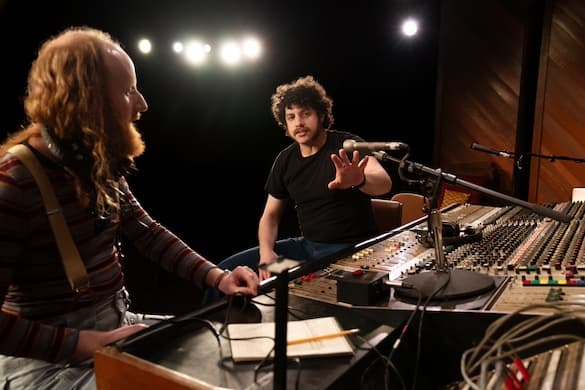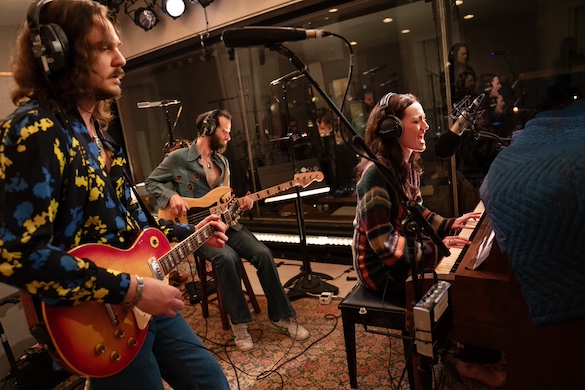Regardless of Whether ‘Stereophonic’ Is Based on Fleetwood Mac and the Making of ‘Rumours,’ the Play Is Riveting
Playwright David Adjmi, for his part, has brushed off the comparisons. ‘There is no real story,’ he told Variety recently. ‘The whole thing is invented.’ Happily, it is a beautifully crafted and consistently compelling work on its own terms.

When I saw David Adjmi’s “Stereophonic” off-Broadway last fall, I was taken aback by how closely the story hewed to one I had been familiar with since childhood. While the playwright, in interviews and program notes, described the play, set in a recording studio in 1976 and 1977, as inspired by different bands and by the process of making art generally, I immediately recognized — I was sure — the musicians being represented and the album they were working on.
Those would be the Anglo-American lineup of the London-raised group Fleetwood Mac and “Rumours,” one of my favorite pop albums to this day — recorded largely at Sausalito, California, and Los Angeles, where “Stereophonic” unfolds, by five artists whose ages, backgrounds, talents, and trajectories were clearly models for the characters Mr. Adjmi presents in this work, now being produced on Broadway.
Mr. Adjmi’s American band members, Peter and Diana, are, like Fleetwood Mac’s Lindsey Buckingham and Stevie Nicks, singers/songwriters and lovers, who were then on the brink of breaking up. Peter, like Mr. Buckingham, is a guitarist and overall sonic visionary; he’s also a controlling perfectionist — a description that has been applied to the real-life musician — with a tyrannical streak. Peter even has a brother competing as a swimmer in the Olympics, as was the case with Mr. Buckingham.
Over the course of the play’s undeniably riveting two acts, we see how Diana feels intimidated and diminished by Peter — as Ms. Nicks has suggested she did during her relationship with Mr. Buckingham — despite having a hit song she wrote for the band’s previous album rising on the charts, as Ms. Nicks did while sessions for “Rumours” were under way.
Then there are the three Brits: singer/keyboardist Holly and bassist Reg, a married couple who are also about to split — just as singer/keyboardist Christine McVie and bass guitarist John McVie did, albeit before recording “Rumours” — and drummer Simon, whose own wife is about to leave him, as drummer Mick Fleetwood’s did.

I could point to more parallels and, to be fair, identify differences, as well as juicy details that were left aside. Mr. Adjmi, for his part, has brushed off the comparisons. “There is no real story,” he told Variety recently. “The whole thing is invented.” (The playwright did, according to the article, borrow a couple of lines from a Metallica documentary — one of many he watched while doing research.)
Certainly, on viewing “Stereophonic” a second time, I was less distracted by the similarities, and therefore better able to appreciate and enjoy what is, without question, a beautifully crafted and consistently compelling work on its own terms. That’s not minor praise, given that the play runs nearly three hours with an intermission, and under Daniel Aukin’s meticulous direction, its pace is gentle and deliberate throughout.
The effect is that of being a fly on the wall during a creative process that is by turns exhilarating and excruciating, with plenty of dull moments in between — not for us, but for the (more or less) fictional musicians, who are left to gossip and argue and stew as technical issues other challenges develop. Drugs and alcohol are involved, as they were for many bands of this vintage, admittedly.
There’s a lot of humor amid the angst; Will Brill proves especially funny as the hapless Reg, who aspires to wax profound while under the influence of various chemicals. Chris Stack’s Simon, the least palpably neurotic bandmate, tends to be jollier, unless his technique comes under question from one of two young engineers — played by Andrew R. Butler and Eli Gelb, both hilarious — who sit by, alternately suffering and, when the coast seems clear, spilling the tea about their crazy employers.
Will Butler, an alumnus of the celebrated latter-day group Arcade Fire, has written several muscular, pulsing tunes that show off the actors’ ability to harmonize gorgeously, when their characters aren’t at one another’s throats. Sarah Pidgeon’s Diana, especially, sings with a resonant but slightly ragged beauty that will do little to dispel the comparisons I’ve made thus far.
Toward the end, Diana is singing with Tom Pecinka’s charismatic Peter and Juliana Canfield’s elegant Holly — Ms. Nicks, Mr. Buckingham and the late Christine McVie alternated as lead singers on “Rumours” — when a technical problem forces them to just stand together for a bit. Within moments, Peter and Diana are screaming viciously at each other, with Holly stuck helplessly between them.
Then the engineers resolve their issue, and the three artists combine their voices again: magnificently, with zero tension between them. Discord gives way to perfect harmony, in an instant; it’s one of numerous times in this story — whether real or imagined — we’re reminded of the transcendent power of art, for the artists and for us.

